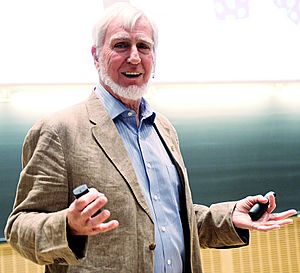John O'Keefe facts for kids
Quick facts for kids
John O'Keefe
|
|
|---|---|

O'Keefe in September 2014
|
|
| Born | November 18, 1939 |
| Citizenship |
|
| Alma mater |
|
| Known for | Discovering place cells |
| Awards |
|
| Scientific career | |
| Fields | Neuroscience |
| Institutions | University College London |
| Thesis | Response properties of amygdalar units in the freely moving cat (1967) |
| Doctoral advisor | Ronald Melzack |
John O'Keefe is a famous American-British neuroscientist. He was born on November 18, 1939. He is a professor at University College London. He is known for his amazing discovery of "place cells" in the brain. These special cells help us know where we are and find our way around. Think of them as your brain's very own GPS!
Discovering Our Brain's GPS
John O'Keefe found tiny cells in a part of the brain called the hippocampus. He called them "place cells." These cells become active when you are in a specific spot. For example, one cell might light up when you are in your kitchen. Another might light up when you are in your bedroom.
This discovery showed that our brain has a special system for knowing where we are. It's like an internal map or a built-in GPS. This helps us remember places and navigate through our world.
In 2014, John O'Keefe won the Kavli Prize for his work. He shared this award with Brenda Milner and Marcus Raichle. The prize was for finding special brain networks for memory and thinking.
He also shared half of the Nobel Prize in Physiology or Medicine in 2014. He shared it with May-Britt Moser and Edvard Moser. They shared the other half of the prize.
O'Keefe and his student, Jonathan Dostrovsky, found place cells together. They carefully studied how individual brain cells in the hippocampus reacted to different things in the environment.
Sharing His Discoveries
John O'Keefe has written many important papers about place cells. These papers have been used by many other scientists. He also wrote a very important book with Lynn Nadel.
This book suggested that the hippocampus acts like a "cognitive map." This map helps us remember places and find our way around. It's all about how our brain understands space.
Many other scientists have continued O'Keefe's work. They have studied place cells in experiments. They have also created computer models to understand them better.

